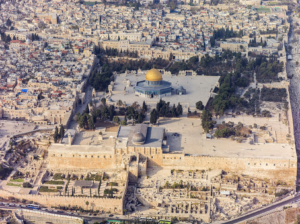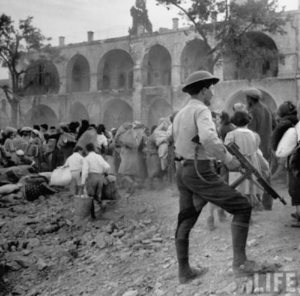Earlier this summer we saw multiple media outlets using various methods to attempt to separate Jews from their holiest site, the Temple Mount. Now National Geographic continues this trend in a long article by Andrew Lawler that privileges the Muslim narrative about Temple Mount. (“An unprecedented look inside one of Jerusalem’s holiest—and most controversial—landmarks,” August 15.)
 The article does not ignore Jewish claims, but it subtly denies their credence. For example, Lawler states that “Many Jews believe the dome [of the Rock] stands on the site of the two previous temples.” (Emphasis added.) A photo caption repeats the misstatement: “Jewish men peer down at a section of the Western Wall, a remnant of the Jewish Temple complex razed by Roman forces in A.D. 70. Beyond rises the dome that many Jews and Christians believe was built on the site of the ancient Jewish Temple.” (Emphasis added.) A sidebar notes only that the two Temples existed somewhere in Jerusalem’s Old City. But as a 2015 New York Times correction and Editor’s Note (prompted by CAMERA) made clear, it’s an archeological fact, not merely a “belief,” that the two Jewish Temples stood on the Temple Mount itself.
The article does not ignore Jewish claims, but it subtly denies their credence. For example, Lawler states that “Many Jews believe the dome [of the Rock] stands on the site of the two previous temples.” (Emphasis added.) A photo caption repeats the misstatement: “Jewish men peer down at a section of the Western Wall, a remnant of the Jewish Temple complex razed by Roman forces in A.D. 70. Beyond rises the dome that many Jews and Christians believe was built on the site of the ancient Jewish Temple.” (Emphasis added.) A sidebar notes only that the two Temples existed somewhere in Jerusalem’s Old City. But as a 2015 New York Times correction and Editor’s Note (prompted by CAMERA) made clear, it’s an archeological fact, not merely a “belief,” that the two Jewish Temples stood on the Temple Mount itself.
Lawler also subtly treats Jewish claims as secondary, or an afterthought and treats Jewish theology as problematic. He writes,
Muslims extol the shrine as Islam’s most important site after Mecca and Medina, while Palestinians honor it as the cherished symbol of their nation. For many religious Jews, however, the structure is an abomination fated to be destroyed to make way for a new Jewish temple. Some evangelical Christians also insist it must be replaced by a new temple to set in motion the return of Jesus Christ. Such a volatile mix of beliefs sends shudders through politicians across the region, who fear any attempt to raze it would result in a catastrophic war.
Lawler doesn’t see it as problematic that a Muslim shrine was built intentionally atop the remnants of a Jewish one, but he does see it as problematic that the Jews would like to have their holy site returned to them. A similar sentiment is expressed in one of the photo captions: “Only Muslims may worship in the dome and the surrounding 36-acre Al Aqsa compound—a rule dating back centuries meant to maintain Jerusalem’s fragile peace. But a growing number of Jews demand the right to pray on the plaza, threatening to upend the tradition.” To National Geographic, it’s the Jews who want to pray at their own holy site, and not the Muslims who want to exclude those Jews, that are a “threat.”
While it may be true that, as Lawler wrote in the above passage, Palestinians today view the Dome of the Rock as an important symbol, the Palestinian people have never in history had sovereignty over it. Only much later in Lawler’s 4000+ word article do we learn that this has emerged as a symbol only “in recent decades,” and he even notes – again, towards the end of the long essay – that at the time the Dome was built, Jerusalem was considered part of the region of Syria. In contrast, Jews first had sovereignty over the city of Jerusalem beginning in 1004 BCE at the time of King David, until about 700 BCE, during which time the First Temple was built. And for 2000 years, since the destruction of the Second Temple, and long before the advent of Islam, Jews have prayed to rebuild it again.
Nor is Lawler correct, in the above passage, about Evangelical Christian theology. The consensus among Evangelicals is that while they do believe that a Third Temple will rebuilt, it won’t require the destruction of the mosque.
Lawler further tells his readers, “as Islam’s oldest building, the dome ranks with the neighboring Church of the Holy Sepulchre in spiritual importance and the Taj Mahal in grace,” again ignoring the holiness of the Temple Mount to Jews.
In some cases his bias is expressed in unbalanced quotes from his interview subjects. “Sireen Karim, a middle-age kindergarten teacher dressed in black, gestures at the mass of stone that dominates the center of the building,” he writes in one of several examples. “‘This is where Muhammad, peace be upon him, ascended to heaven to meet all the prophets, and where he came back with the message to pray five times a day,’ she says. ‘It also healed his sadness. And this is where we come to cure our grief and ease a troubled state of mind.’” Beliefs about Muhammad’s connection to the site are surely sincerely held, but unlike the claims about the two Temples, they are unprovable. This location was holy to Jews for centuries before Muhammad even lived, possibly making this one of the earliest acts of cultural appropriation.
There are other, more political distortions in the article as well. “Today the Dome of the Rock also stands at the center of one of the world’s thorniest geopolitical disputes, and its golden vault is a frequent backdrop to violent confrontations between Palestinian worshippers and Israeli police,” Lawler writes. But those who throw firebombs from inside the Al Aqsa Mosque that is next to the Dome, as happened in 2022, or who “hurl[] rocks and other objects from the [Al Aqsa] holy site and launch[] fireworks at officers,” as happened in 2021, or who, this year, as mentioned in Lawlers’s article, barricade themselves inside the mosque with fireworks, cannot rightly be termed “worshippers.”
In one of the more bizarre passages in his essay, Lawler touts a supposed era of tolerance while Jerusalem was under Muslim rule, and contrasts that to the 1984 plot by Jewish extremists to blow up the Dome.
Their most controversial claim is that the shrine was open not only to Muslims but also to Jews, Christians, and Zoroastrians during what St. Laurent calls “a period of inclusivity.” As commander of the faithful, Muawiya asserted his role as leader of all the monotheistic faiths. That the city’s new Islamic rulers allowed Jews to return and permitted Christian worship is well attested in contemporary documents, supporting the idea of a fleeting era of something more than simple religious tolerance. Seen this way, says St. Laurent, the dome was the diadem in “Muawiya’s vision of unity.”
Such harmony is elusive in the modern Holy City. In 1984, encouraged by an extremist mentor, Yehuda Etzion gathered 660 pounds of stolen dynamite and a handful of other ultranationalist Jews. Their goal was to blow up the dome.

Jews being evacuated after Jordanian capture of Jerusalem, 1948, via Israel Matzav blog.
Lawler has simply skipped right over the 1920 and 1929 riots against Jews in Jerusalem, as well as the 1948 expulsion of Jews from the Old City of Jerusalem when it came under Jordanian rule. He fails to note the 2014 shooting of Jewish Temple Mount activist Yehuda Glick, the 2017 shooting of two Israeli police officers right outside of the Temple Mount or the standoff over metal detectors that immediately followed it, or the routine harassment of Jews in modern times who try to visit the Temple Mount. Nor does he mention that anytime Jews lived under Muslim rule, they were subjected to second-class or dhimmi status. Instead, he creates a false impression that Muslim tolerance and Jewish violent extremism are the norm.
Even more troubling, Lawler presents the 1982 and 1984 violent extremist Jewish attacks on the mosque compound as part of the same continuum as Jews who simply wish to pray at the Temple Mount and also the Israeli response, earlier this year, to Palestinian rioters inside the Al Aqsa mosque.
Lawler’s vivid description of the inside of the Dome of the Rock, as well as his detailed account of recent renovations, were extremely interesting to read. But his biased account of the history and the religious significance of the site weren’t on par with the traditional standards of National Geographic.
Dr. Tricia Miller contributed to this article.
